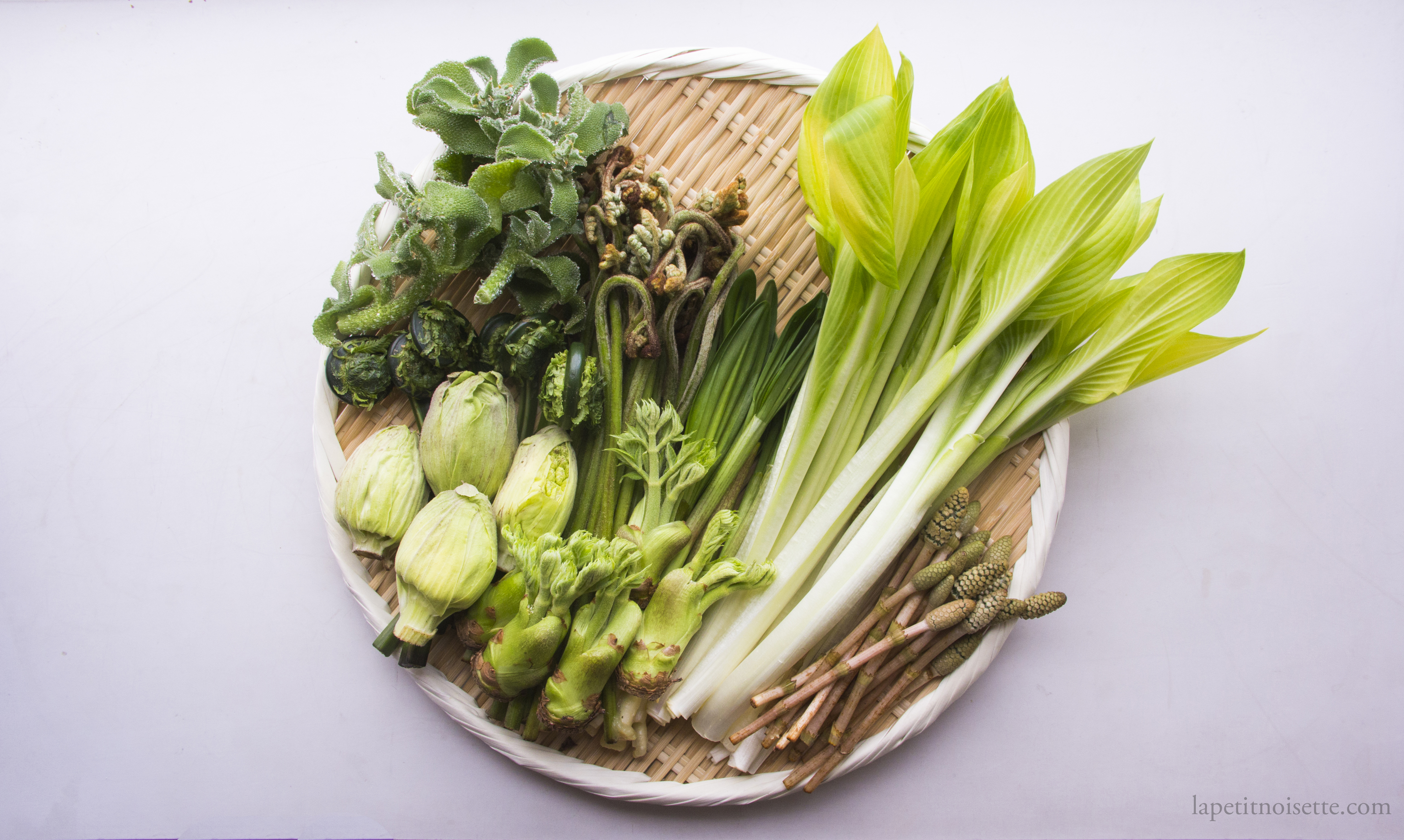
As spring arrives in Japan just around the blooming of plum trees and just before that of the cherry blossom trees, the snow on the mountains start to melt, while a variety of wild green shoots start to peak through the soil. Many of these plants have come to be known as Sansai (山菜), a group of wild harvested mountain vegetables with supposedly health benefits and a characteristic bitter taste. The discovery of Sansai is typically attributed to Uesegi Yozan (杉鷹山), who was commissioned by the emperor that time to identify edible wild plants that would help elevate the famine and lack of food that Japan was experiencing at that time. Sansai also played an important role in shojin ryori (精進料理), which is the traditional religious cuisine served in Buddhist temples all around Japan, especially in Kyoto. Today, various types of Sansai can be seen to start appearing on the shelves of some higher end Japanese super markets as well as almost all outdoor vegetable markets. Today, the majority of the Sansai being sold is farmed instead of foraged, as a number of these vegetables have been able to be cultivated. The taste between wild harvested Sansai and cultivated ones are striking, with wild ones typically having a much more intense and bitter flavour.
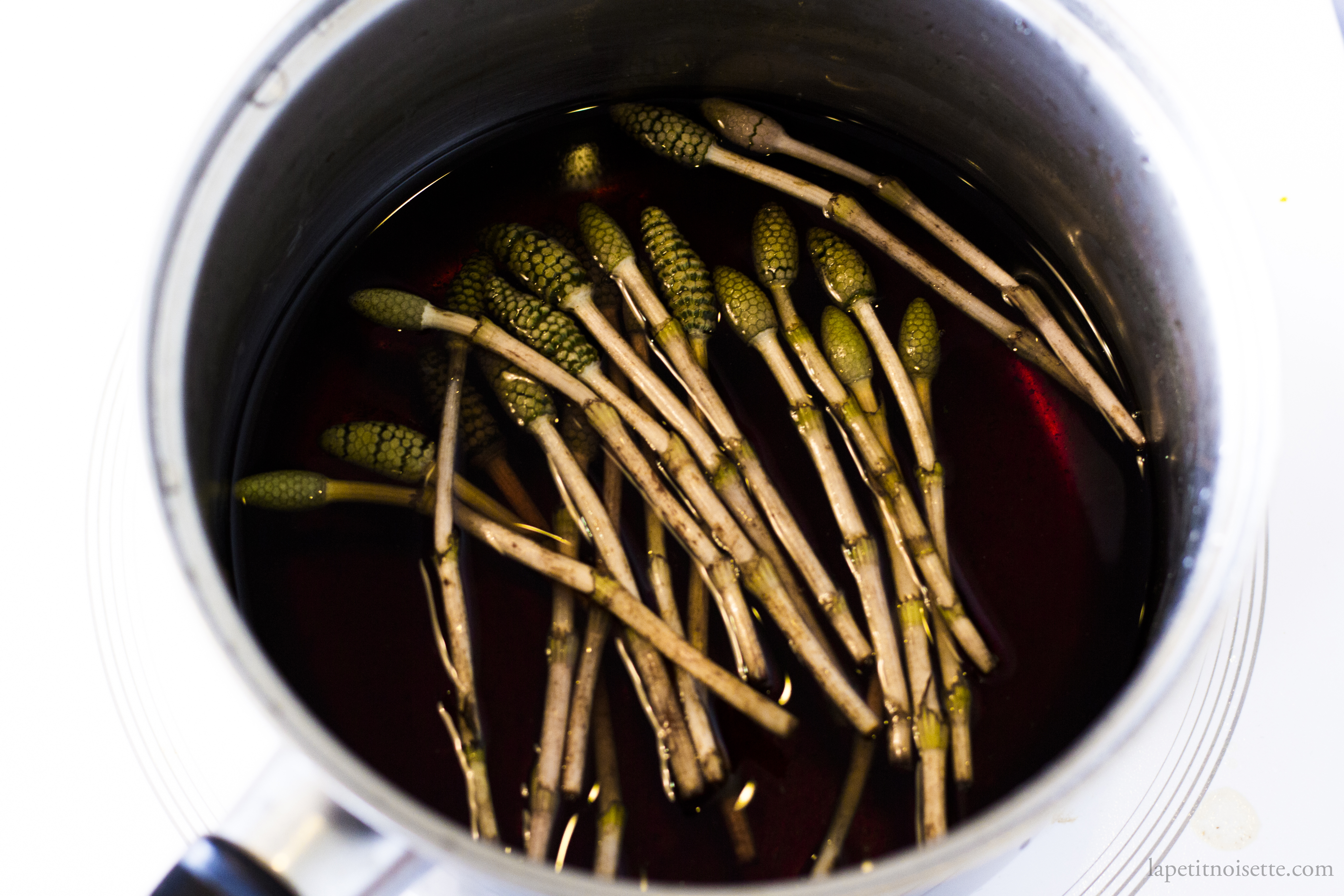
From a biological standpoint, this is extremely interesting because the evolution of the ability to taste bitterness is typically associated with its use in identifying poisonous foods. This can also be seen in children, who are much more sensitive to bitter tastes compared to adults, with the currently accepted theory being that it would prevent children from accidentally poisoning themselves when out exploring without adult supervision.
Following on this train of logic, it would be easy to see why Sansai (the bitter ones anyway) might be poisonous, and there might be some truth to this. First and foremost, not all Sansai is bitter, and all the types of Sansai you can see in supermarkets nowadays have been consumed for many generations with no significant side effects. This being said, a few of the fern-related Sansai have been known to contain a very low concentration of toxic compounds. For example, Warabi (ワラビ) or Bracken fern, is know to cause stomach cancer in cattle and horses even though they are used as vegetables in Japan and Korea (고사리나물). In fact, the animals themselves seem to know it and only will eat bracken when there is no other grazing alternative.
The following is a subset of the more common Sansai you can find in Japan and a simple recipe that follows each one.
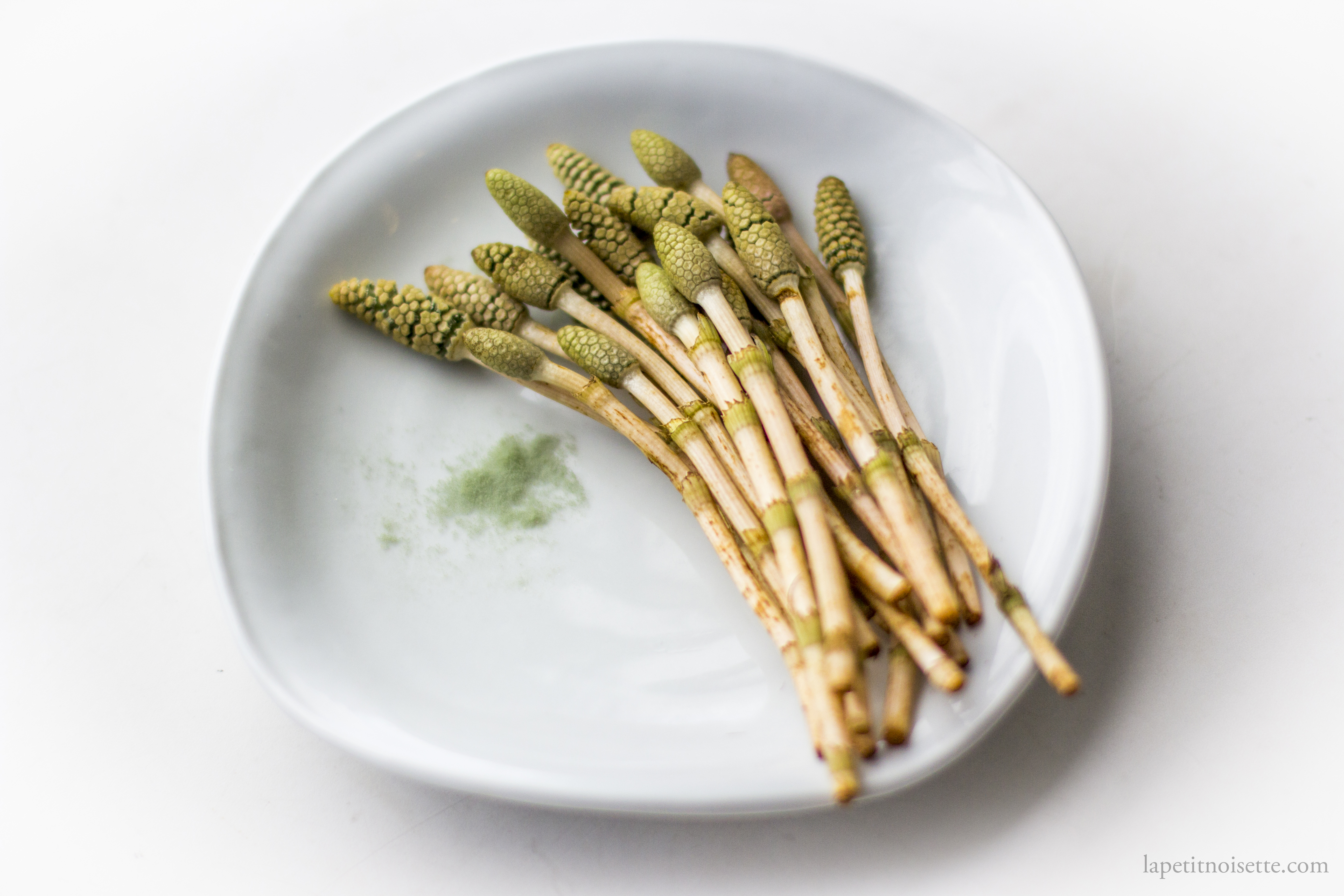
土筆 (tsukushi), Field Horsetail, Equisetum arvense
Tsukushi tends to sprout towards the end of March and are an extremely common plant, so much that it can sometimes be seen at field edges and roadsides. The head of Tsukushi looks slightly like a morel mushroom but much smaller. This head contains the green powder resembling matcha power that is the main source of its bitter taste. It is even possible to tap the Tsukushi stalks gentle to obtain this powder. If the Tsukushi is large and thick, you can gentle remove the knobs along the stalk of the stem using your fingernails, but this is almost never needed (like the knobs along asparagus). The Tsukushi is then cooked and can be used as a rice topping like Furikake (ふりかけ).
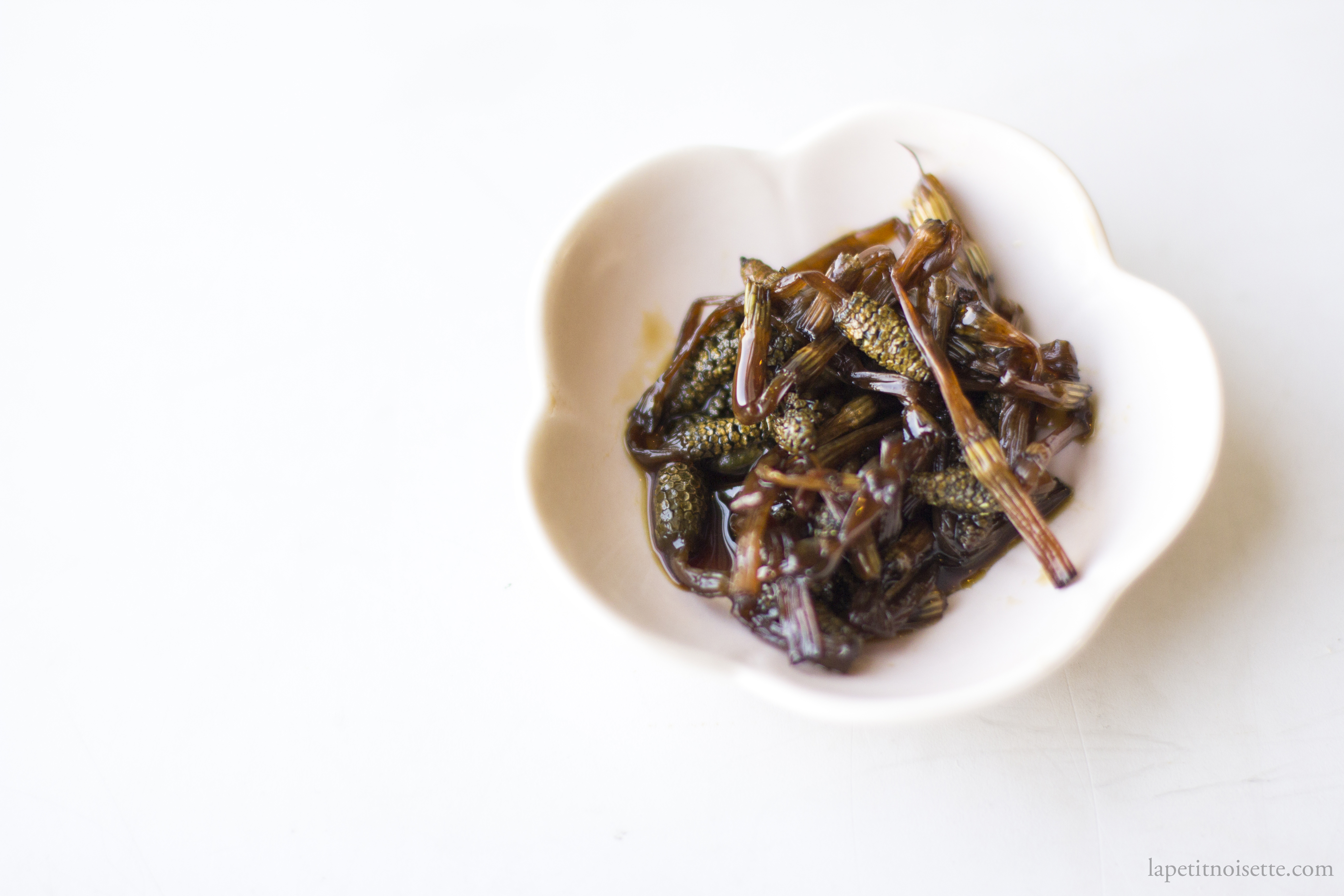
Soy Sauce Glazed Tsukushi
- 60g of Tsukushi
- 50ml Mirin
- 50ml Soy Sauce
- 15g to 20g of Sugar
- 10g of Sake
- 200ml of water
- Combine the ingredients excluding the Tsukushi and bring to a boil in a small saucepan.
- Add the Tsukushi and simmer for 10 to 15 minutes until tender.
- Remove the Tsukushi and reduce the remaining liquid over high heat until it coats the back of a spoon. Be careful not to burn the sauce.
- Turn off the heat and return the Tsukushi to the pan and mix together.
- Serve on top of rice and as a side dish.
うど(Udo/独活), Japanese Mountain Asparagus, Aralia cordata
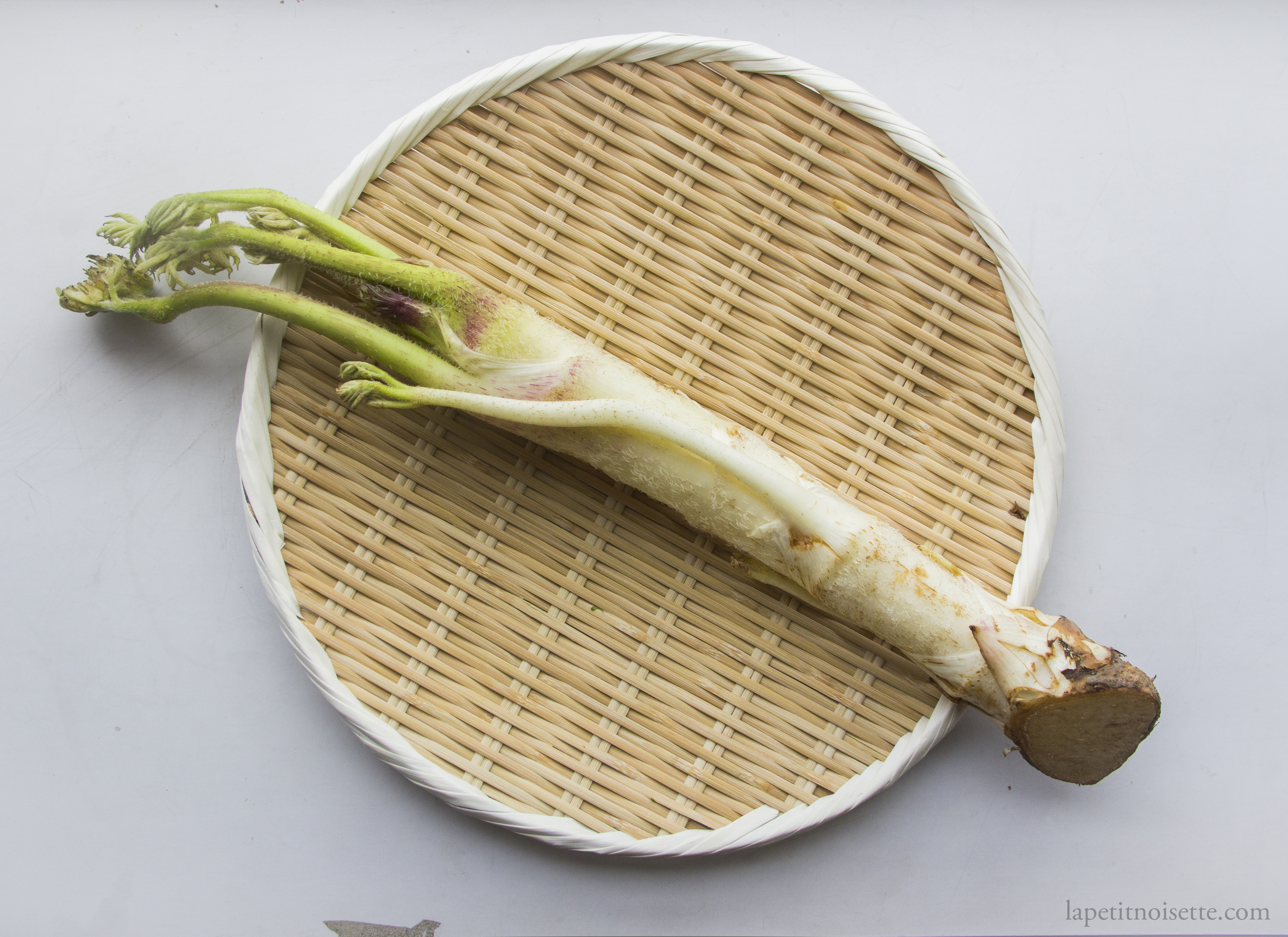
Udo, or Japanese mountain asparagus, is personally my favourite Sansai. It is a herbaceous perennial plant (lives more than 2 years and produces no woody stems) that grows up to 3 meters each year. It has the ability to die back each winter before growing again during the spring. It is typically harvested at around 1 meter in height. It shares many similarities to a typical asparagus in that is can be cooked in the same way (pickled or sauteed) but is 4 to 5 times thicker in width than a green asparagus. Similar to a white asparagus and due to its thickness, it’s outer layer is tough and bitter and needs to be peeled before cooking. The taste or Udo is very different compared to asparagus however, and reminds me of pine resin, lemon and celery in a sort of very refreshing way.
Soy Sauce Marinated Udo (うどの漬物)
- 400g of Udo
- 40ml Soy Sauce
- 10ml Mirin
- 10g Sugar
- 1 Garlic Clove
- 20ml Dashi
- Start by preparing the Udo. Wash the Udo thoroughly under water.
- Cut off the smaller stems of the Udo with the leaves attached.
- Peel the remaining main thick stalk of the Udo. The fibres run along the entire length of it and thus after peeling a little of the skin off the bottom of the Udo, it should be easy to pull it off all the way to the top.
- Cut the main thick stalk of the Edo into 4cm pieces or just follow the Udo’s natural segments.
- Cut the segments into 6 equal pieces lengthwise. (The smaller the pieces the faster they pickle)
- Mix all the other ingredients together and submerge the Udo stalk, stem and leaves. This can be done in a container or ziplock bag.
- They are ready to eat after 4 to 5 hours and can be pickled up to 5 days.
- Remove from pickling liquid after 5 days. They can keep up to a week in the fridge after pickling.
Butter Sautéed Udo
- Udo
- Salt
- Sugar
- Butter
- Feta/Ricotta Cheese
- Cherry Tomatoes
- Balsamic Vinegar
- Wash the Udo well underwater and remove all the stalks and leaves.
- Peel the main stem twice because you only want the soft tender inner layer. Peeling off one layer will only expose Udo flesh that is too tough to sauté.
- Cut the Udo length wise according to its natural segments.
- Next, cut the Udo into thin strips using a sharp knife or mandoline.
- Sauté the strips in butter, sugar and salt until tender.
- Mix with cherry tomatoes, cheese and balsamic vinegar before eating.
蝦夷ねぎ(Ainu Negi), Wild Garlic/Siberian Onion, Allium ochotense
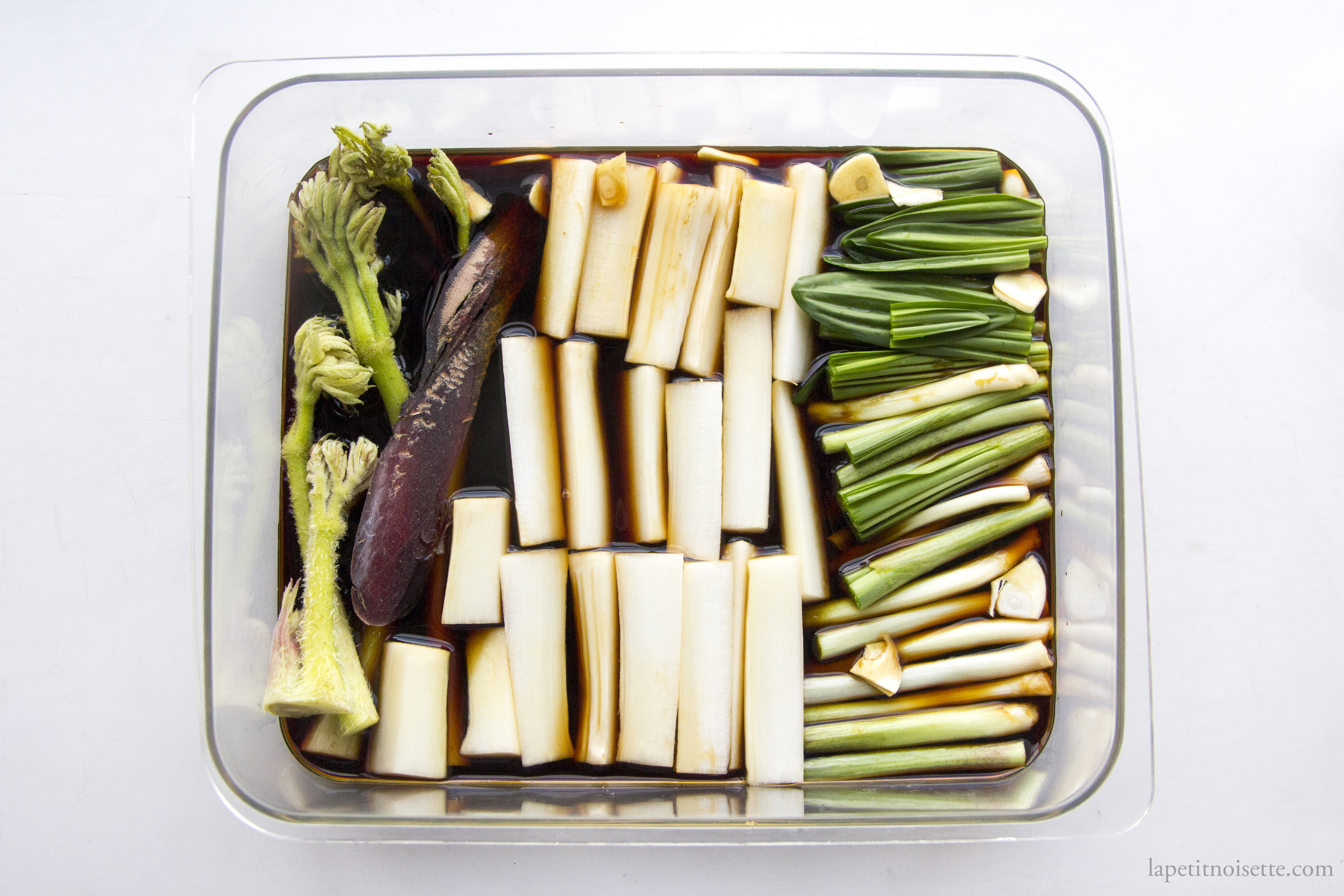
This Sansai is also known as gyoja ninniku (ギョウジャニンニク/行者葫) and essentially can be used in the same way wild garlic is used in cooking. Tastewise, it is much more pungent and closer in smell to garlic chives mixed with spring onions. They go bad quickly and become slimy if not stored in the fridge and consumed quickly. The name Ainu Negi was giving due to their use by the indigenous Ainu people of Japan who harvested the leaves and dried them for use in their cuisine such as a ohaw (オハウ), a type of soup/stew made from meat or fish. In terms of western cuisine the Ainu Negi can be used to make wild garlic infused olive oil, or even wild garlic pesto.
Soy Sauce Pickled Ainu Negi 蝦夷ねぎの漬物
- 80g of Ainu Negi (or wild garlic leaves)
- 40ml Soy Sauce
- 10ml Mirin
- 10g Sugar
- 1 Garlic Clove
- 20ml Dashi
- Rinse the Ainu Negi and cut off the roots.
- Blanch in hot water for 4 to 5 seconds before stopping the cooking process in cold water/ice water.
- Mix the rest of the ingredients together and submerge the Ainu Negi.
- The Ainu Negi is ready to eat in 3 hours and keeps for up to a week.
- The pickling liquid is basically the same as that for Udo and they can be pickled together.
- You actually don’t have to blanch the Negi before pickling but the flavour will be stronger.
ふき(Fuki/蕗), Butterbur, Petasites japonicus
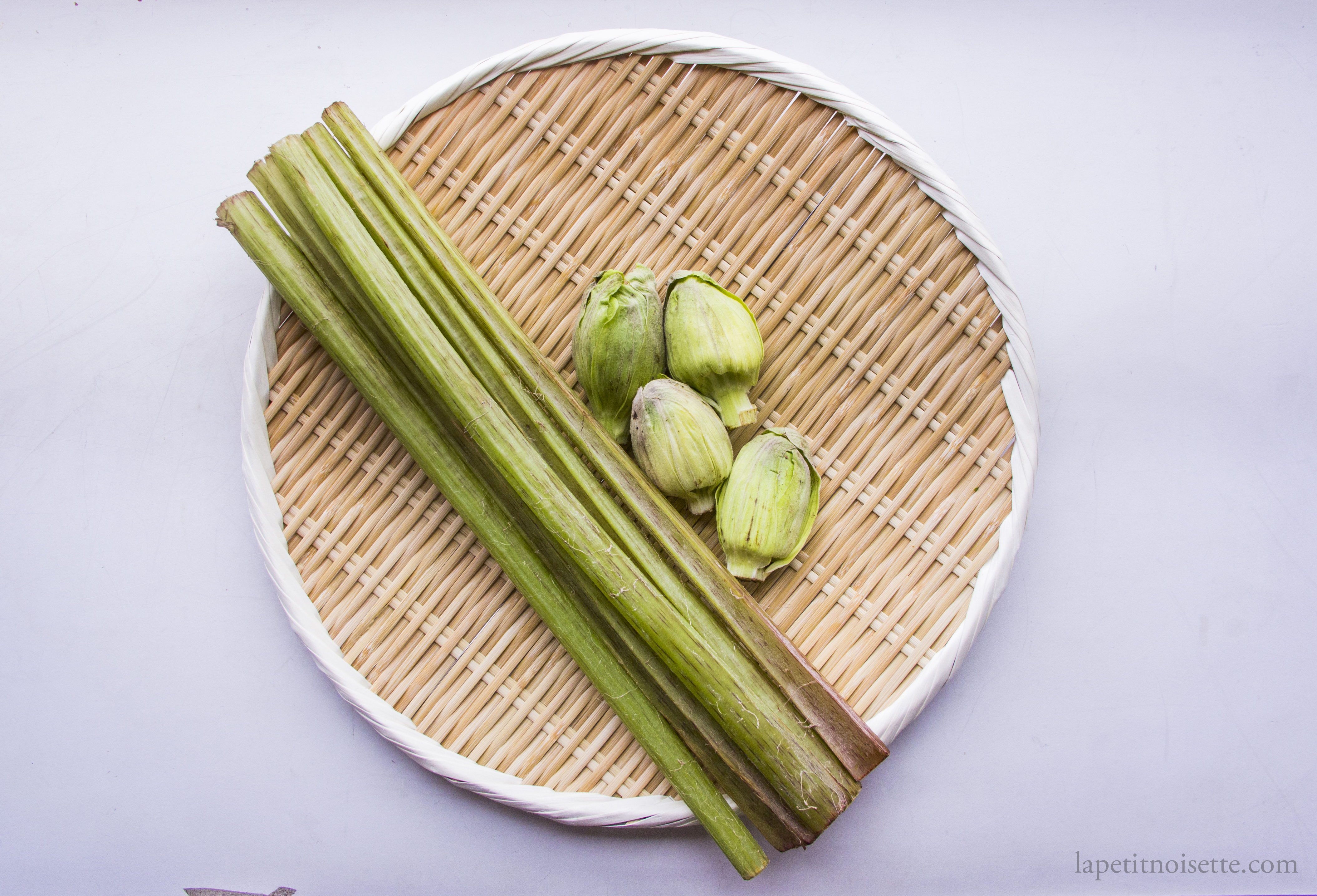
Butterbur is a plant with big leaves resembling lilies and stalks that look almost exactly like celery stalks. The buds and stalks of the butterbur are edible, with the stalks having a texture similar to celery after peeling. To me, the butterbur is the most bitter of most Sansai to the point of inedibility but a few of my friends absolutely love it. The larger the butterbur plant grows the more bitter it becomes and therefore are usually harvested early. After cooking, the stalks are usually pickled in miso to mellow out their bitter taste. The buds (フキノトウ/ふきぼこ) can also be fried in miso to balance the bitterness.
Fuki Stalk Miso Pickle 蕗(ふき)味噌漬
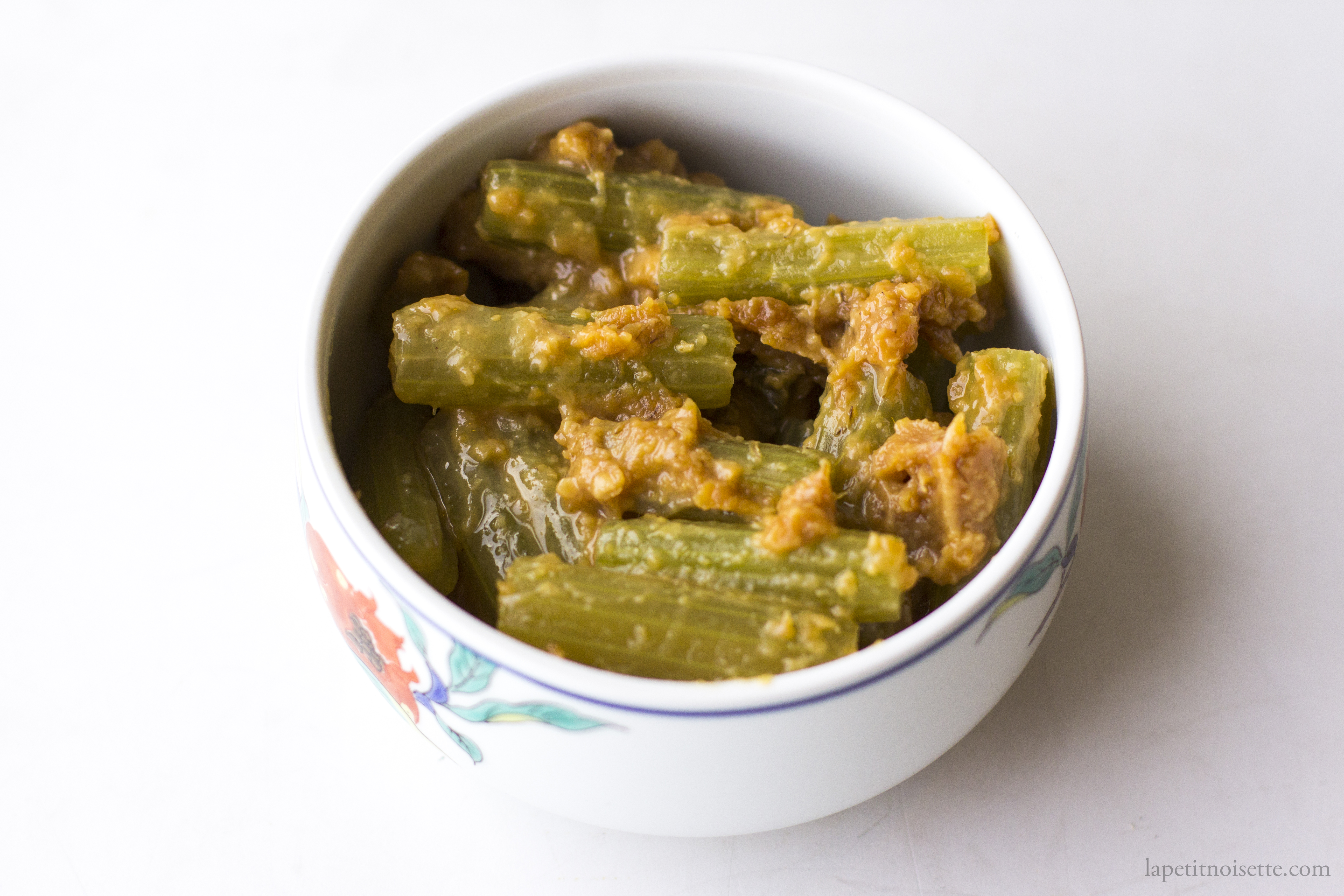
- 500g of Fuki Stalks
- 30g of Sugar
- 15ml of Mirin
- 150g White Miso
- Wash the Fuki Stalks and boil in lightly salted water until tender to the touch or limp (cannot be held straight). This takes around 5 to 10 minutes. It can take longer if the stalks are old.
- Let the stalks cool down and peel the stalks by stripping the outer layer using your fingers from the tips of the stalks.
- Cut the stalks into bit size pieces and mix together with the rest of the ingredients.
- Allow to pickle for at least 12 hours and up to 5 days.
- This will keep for a week after pickling.
- This recipe can be done with Red Miso but the taste will be stronger and more savoury
Stir Fried Miso Fuki Budsフキノトウの味噌炒め(ふきぼこの味噌炒め)
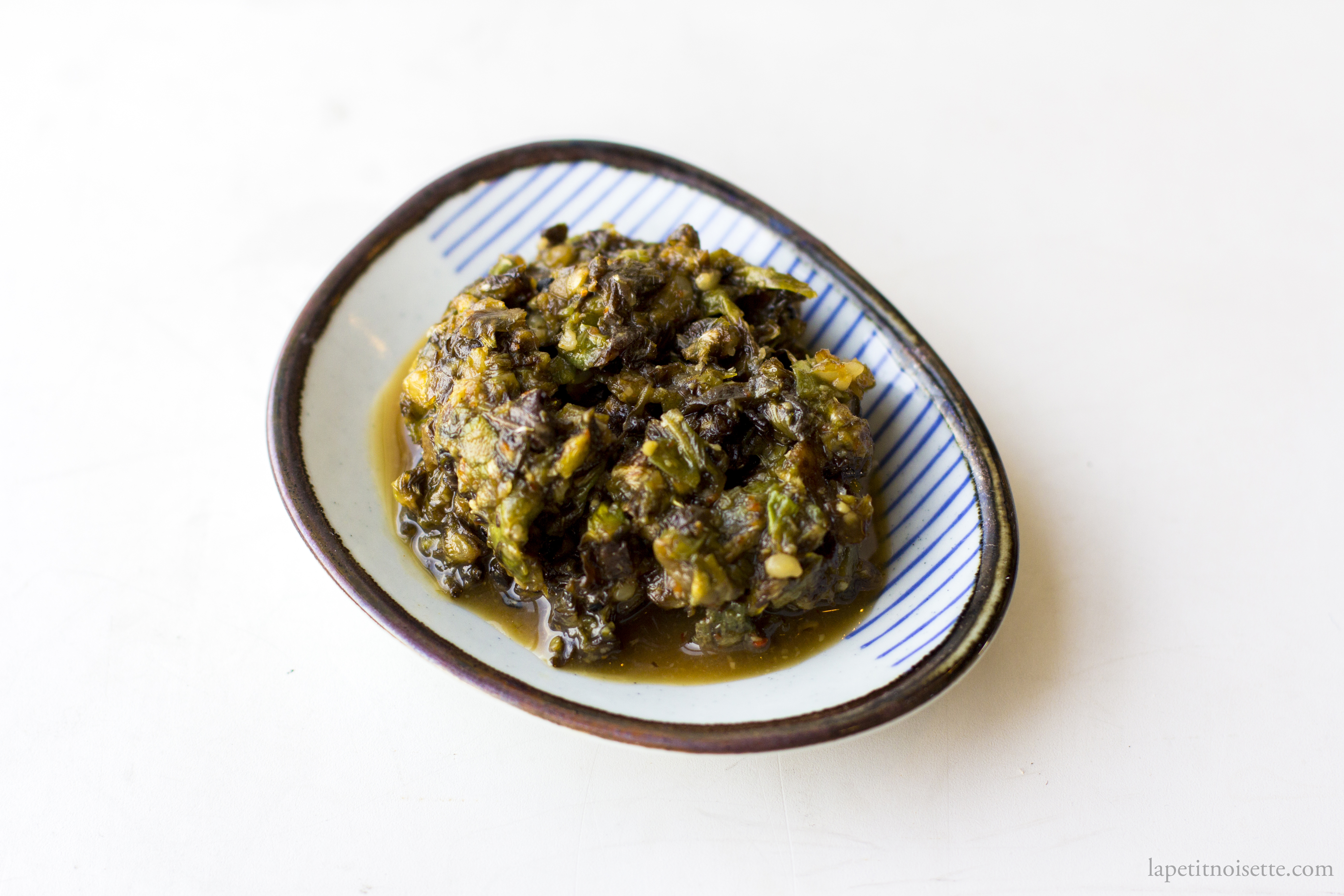
- 200g of Fuki buds
- 30g of White Miso
- 30ml of Dashi
- 15g Sugar
- 15ml Sake
- Drizzle of Sesame Seed Oil
- Sansho Pepper (Optional)
- Slice the Fuki buds up thinly.
- Fry the buds in sesame seed oil until slightly brown and wilted.
- Add in the White Miso, mix well and continue frying.
- Add in the dashi, sugar and sake and reduce until it thickens up.
- Sprinkle on Sansho pepper and serve with rice as a side dish.
たけのこ(Takenoko/筍/竹の子)
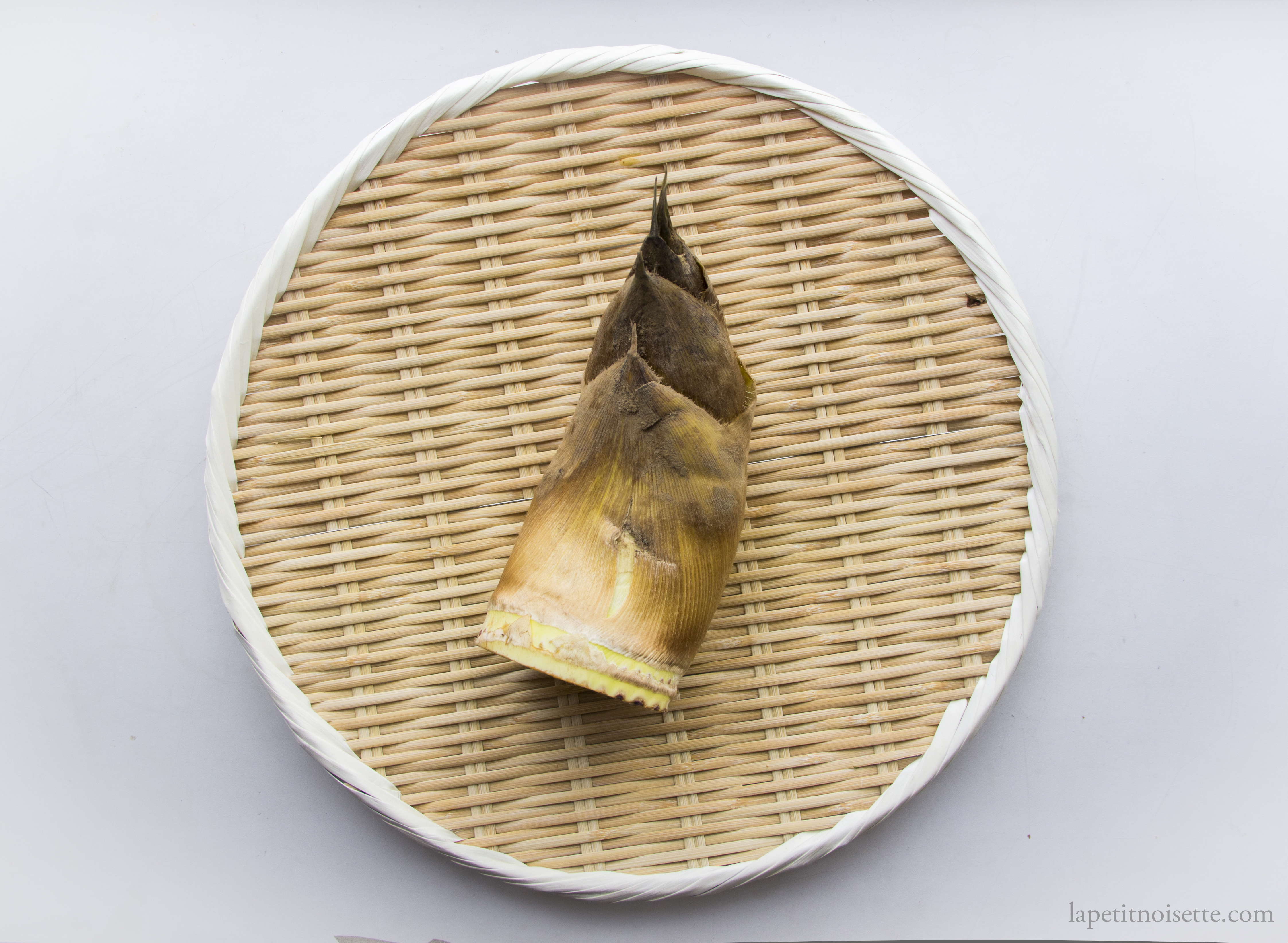
Takenoko are baby bamboo shoots that’s main body is still underground. Because of this, they need to be dug up and cleaned before eating. They can be found all over Asia and are not unique to Japan. They are however, only available for a short period of time during spring and can only be found canned for the rest of the year. In the same way that astringent vegetables (such as garlic) is sometimes cooked in milk to mellow out its flavours, bamboo shoots can be cooked in rice water to help mellow out it’s bitterness. Rice water is water saved from washing rice and therefore the best way to use the bamboo shoots is by making bamboo shoot rice. Fresh raw bamboo shoots may be a hassle to prepare or obtain and can be replaced with canned or pre-cooked ones.
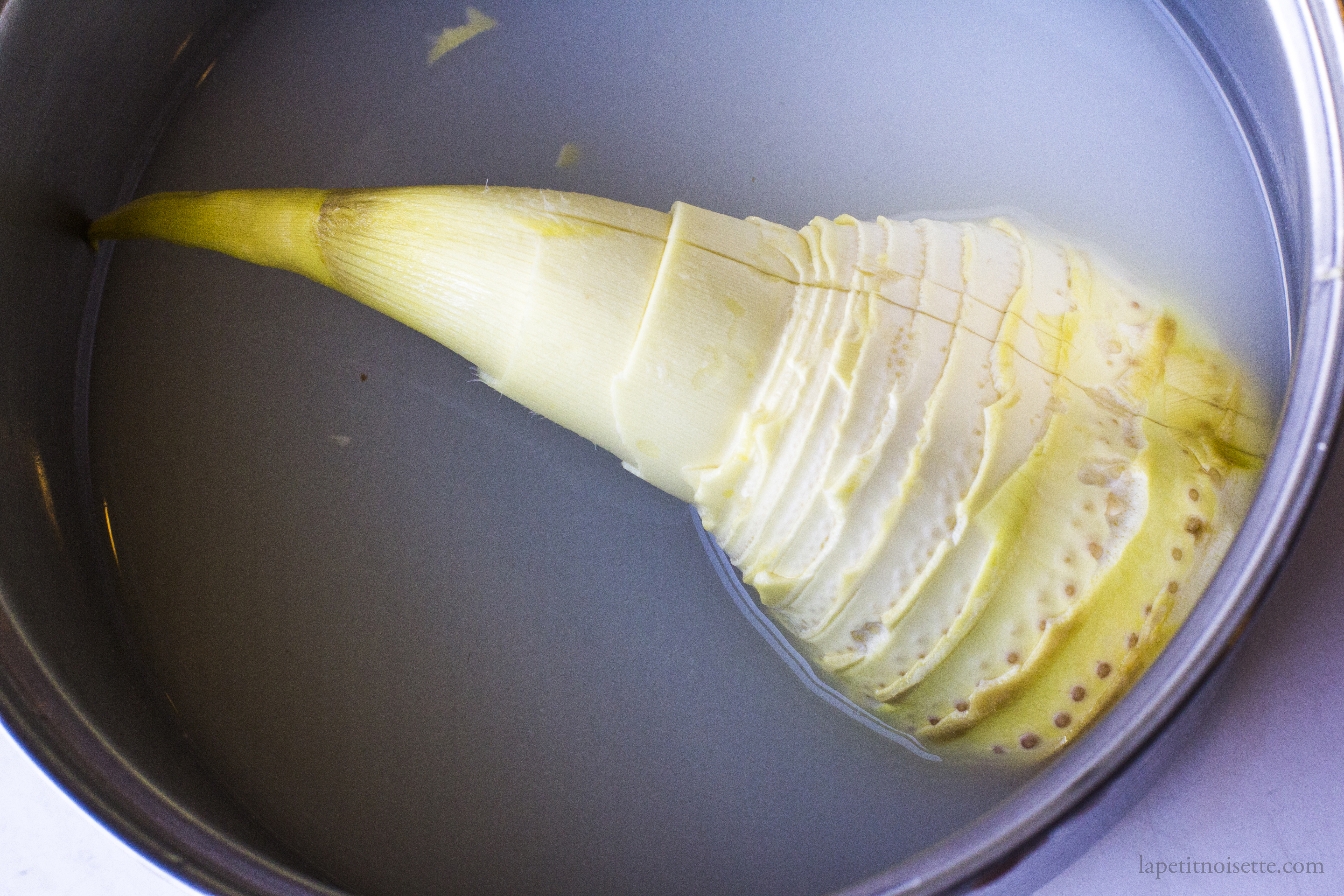
Takenoko Gohan たけのこご飯
- 2 Cups/360ml White Rice
- 2 Raw Bamboo Shoots/Pre-cooked Bamboo Shoots
- 30ml Sake
- 30ml Mirin
- 30ml Soy Sauce
- 360ml Dashi
- Mitsuba Parsley
- Wash the Bamboo shoot carefully to remove as much soil as possible.
- Wash the rice until clear and reserve the water, do not start cooking the rice yet.
- Carefully slice down the centre of the bamboo shoot just deep enough to penetrate the tender inside and peel away the hard layers.
- Simmer for 30 minutes in rice water until tender.
- Remove from water and allow to cool and slice the Bamboo shoots thinly
- Add the rest of the ingredients into the rice as well as the Bamboo shoots before cooking as you would normal rice. (e.g. start the rice cooker)
- Serve with mitsuba parsley.
ワラビ(蕨/Warabi), Bracken Fern, Pteridium
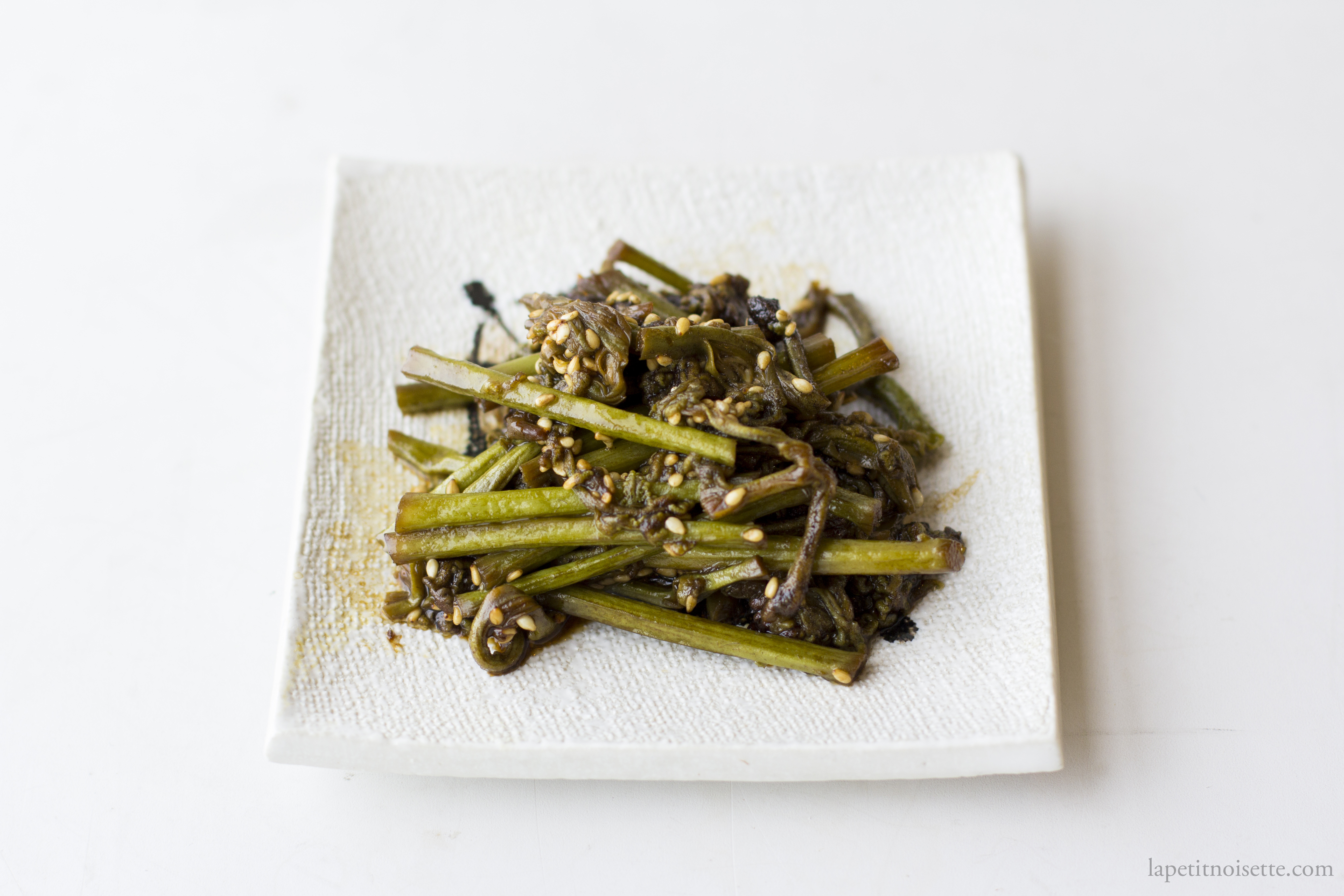
As mentioned above Bracken fern is known to cause stomach cancer in cattle and horses even though they are used as vegetables in Japan and Korea (고사리나물). In fact, the animals themselves seem to know it and only will eat bracken when there is no other grazing alternative. In order to make it safe it eat, bracken needs to be cooked for a long time. Bracken fern is also used to make mochi. The taste of Bracken is similar to that of sea herbs, with a mildly sea like/fishy taste that isn’t too pungent after cooking. This is my second most favourite Sansai after Udo.
- 300g Warabi
- 30ml Soy Sauce
- 10ml Perilla Oil
- 5ml Sesame Seed Oil
- 5ml Vegetable Oil
- Sesame Seeds to finish
- Bring a pot of water up to simmer and boil the Warabi for an hour before letting it sit in the hot water for 2 more hours.
- Drain the the Warabi well before stir frying with the rest of the ingredients.
- Mix in the sesame seeds.
- Serve with rice as a side dish.
- This can last in the fridge covered for 4 to 5 days.
こごみ (Kogomi), Ostrich Fern, Matteuccia struthiopteris
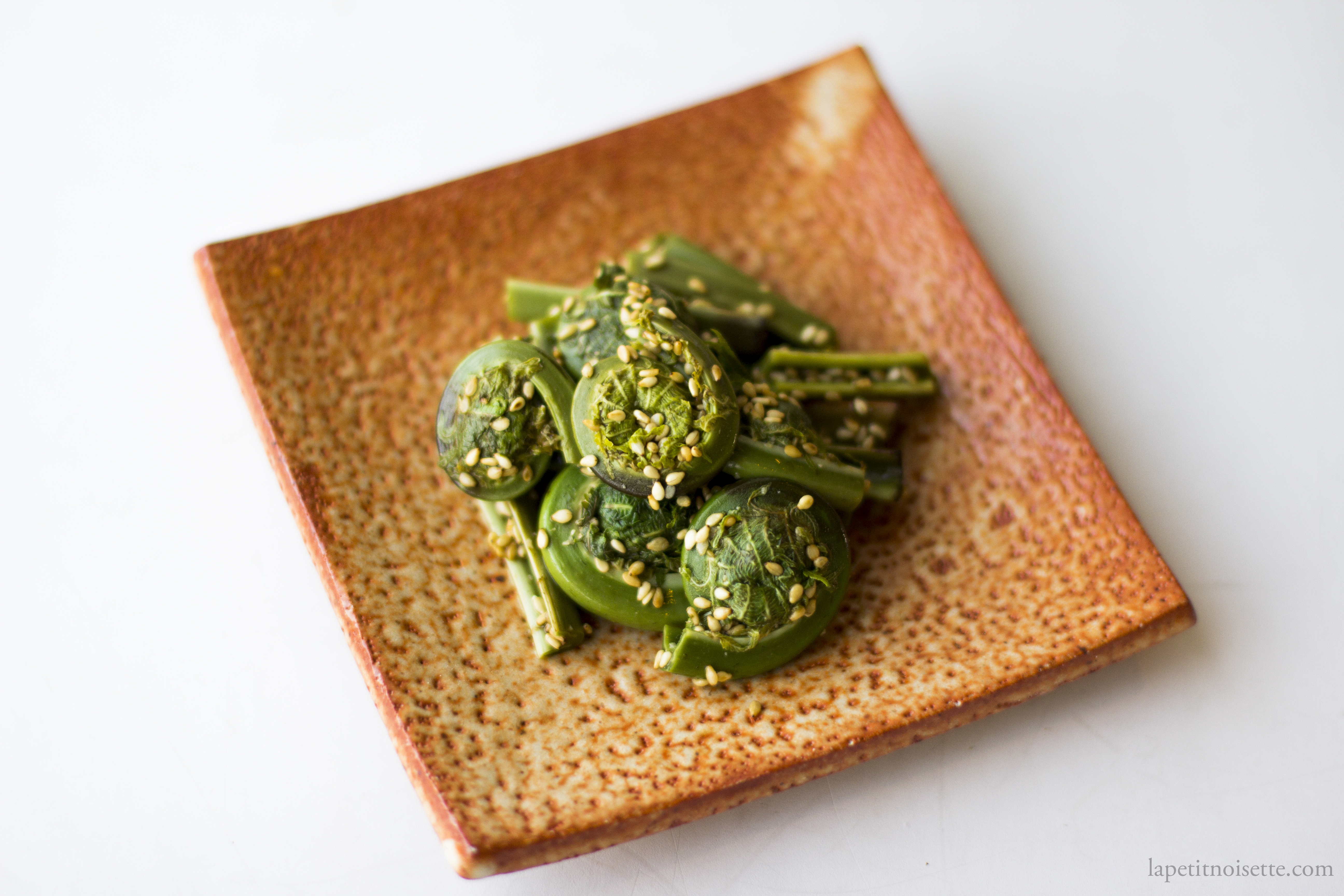
Kogomi, like Warabi, is also in the fern family and is suspected to have negligible amount of toxins in it. It therefore needs to be cooked before consumption, though not boiled for an extended period of time like Warabi. Kogomi is found growing in the wild but is not native to Japan. It is also quite bitter, but the bitter is slightly removed when cooked.
- 60g of Kogomi
- 5g of Sesame Seed Powder/Ground Sesame Seeds
- 3g of Sesame Seeds
- 5ml of Soy Sauce
- 3ml of Mirin
- 3ml of Sake
- 10ml of Dashi
- Wash the Kogomi in cold water and gently remove any hairs on the fern.
- Cook in a pot of lightly salted simmering water for 3 to 5 minutes before draining.
- Mix the rest of the ingredients together and coat the
- Coat the Kogomi and serve with rice as a side dish.
- You can grind sesame seeds yourself to make the paste.
たらの芽(taranome), Japanese angelica tree, Aralia elata
Taranome is just the young shoots of the Japanese angelica tree that are harvested when they start to peak through the soil. As they grow larger, they become more and more bitter, just like Fuki. Unlike other Sansai, Taranome can be frozen. The typical way this dish is cooked is by tempura.
うるい (Urui)
Cultivated Urui has long white stems/leaves that are completely safe to eat raw. Therefore, they can be used in salad to add a crunch texture similar to lettuce. They have a relatively mild taste but can go slimy if left for too long, just like the Ainu Negi. Wild Urui however, have darker green stems and are significantly more bitter. They are typically cooked in tempura.
つぶりな(ツブリナ/Tsuburina), Japanese Ice Plant, Mesembryanthemum crystallinum
Whilst not strictly considered a Sansai, the Japanese Ice Plant comes into season around the same time. The get their name from the shiny and glittery-like diamond cells on the leaf surface that serve as mineral storage organs. Because of this, the Japanese ice plant has a distinctively salty taste. The baby leaves of the plant are safe to eat raw but the plant is usually cooked in tempura.
Tempura batter for Taranome, Fuki, Ido, Ainu Negi Urui and Tsuburina 山菜の天ぷら. Read more about tempura here.
- 1 large egg (around 50g)
- 200ml of Cold Water
- 250g of flour (cake flour if possible)
- The ratio of flour : water + egg should be 1:1
- All Purpose flour for dusting
- Oil for deep-frying
- Whisk the egg and cold water together.
- Add in the flour and lightly beat for a short while, leave the batter thin and lumpy.
- Heat a pot of oil to 170°C
- Cut the Sansai into bite size pieces and coat lightly with flour.
- Dip the Sansai into the batter before lowering into the deep fryer.
- Fry until crisp and lightly golden, 3 to 4 minutes.
- Let the tempura sit on a rack or paper towels to absorb the excess oil and serve immediately.
Interesting veggies! I was in Japan as a tourist just couple of weeks ago. Two dishes that I really relished: Vegan Black Sesame Ramen (at T’s Tan Tan) and the vegetarian curry puff. It will be great if you could share the recipes. Thanks!
Fascinating and very pretty! I only fairly recently started to cook some simple Japanese cooking, even though I have long been an admirer of the cuisine, it is just so different and delicious.